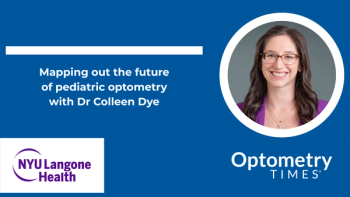
New questionnaire may be useful for assessing quality of life in patients with vision-degrading floaters
The National Eye Institute Visual Function Questionnaire was a tool that has been used previously to assess the patient-reported vision-related quality of life in patients with floaters.
A recently published study found that the newly developed Vitreous Floaters Functional Questionnaire (VFFQ) was a useful tool to assess the quality of life of patients who have vision-degrading myodesopsia caused by vitreous floaters.1 Justin H. Nguyen, BA, first author from VMR Consulting Inc., Huntington Beach, CA, and colleagues reported their findings in JAMA Ophthalmology.
The investigators’ rationale for the study lies in the fact that past studies using quantitative ultrasonography have reported degraded contrast sensitivity2-5 that was correlated with both increased vitreous density6,7 and poor visual quality of life.7 They explained that ultrasonography was found to be correlated with vitreous light scattering,8 supporting its use as a surrogate for measuring light scattering in vivo. “Evaluating the contrast sensitivity and quantitative ultrasonography enables the diagnosis of vision-degrading myodesopsia,5,6,7 but an informative assessment of subjective patient disturbance is lacking,” they said.
The National Eye Institute Visual Function Questionnaire (VFQ) was a tool that has been used previously to assess the patient-reported vision-related quality of life9,10 in patients with floaters, the investigators pointed out. However, the VFQ does not specifically address the association between floaters and quality of life, they explained.
“While an expanded version (VFQ-39) was slightly more useful,11 and although algorithms can improve interpretability of the National Eye Institute VFQ,12 a floater-specific questionnaire might be a better way to assess the association of vitreous floaters with patient-reported, vision-related QOL,” they commented.
Nguyen and colleagues theorized that “Floater-specific, vision-related, patient-reported outcomes might improve assessment of disease severity and case selection for therapy as well as provide useful outcome measures of present and future treatments.”
Floater study goal
The investigators’ goal was to develop a VFFQ and determine if the questionnaire score was correlated with the vitreous density measured by quantitative ultrasonography and with the visual function evaluated by measuring the contrast sensitivity, they explained.
The investigators conducted a cross-sectional study that included 169 patients (mean age, 57.5 years; 43.8% women) with floaters. The patients completed the questionnaire and underwent ultrasonography, measurement of the contrast sensitivity, and clinical evaluation.
The test-retest reliability of the VFFQ was evaluated 3 times over 6 months in another 24 patients (mean age, 56.0 years; 58.3% women).
The researchers evaluated the correlations between the VFFQ score and contrast sensitivity and quantitative ultrasonography as performed in a separate group of 224 participants (mean age, 58.5 years; 44.2% women).
How well did the questionnaire perform?
Based on the 169 participants, the investigators reported that Rasch analysis identified 23 questions that were acceptable for inclusion in the VFFQ and eliminated 8 questions.
They found high test-retest reliability (0.850 [95% CI, 0.721-0.928]; P < .001) in the 24 patients who completed the questionnaire 3 times.
The 224 participants showed significant correlations between the VFFQ-23 scores and vitreous echodensity (r = −0.752 [95% CI, −0.805 to −0.688]; P < .001) and contrast sensitivity (r = −0.744 [95% CI, −0.799 to −0.677]; P < .001).
Nguyen and colleagues concluded, “The VFFQ-23 seems to effectively quantify the subjective association of the visual phenomenon of floaters caused by vitreous opacities with vitreous structure, visual function, and quality of life. The VFFQ-23 appears useful for identifying more severely affected individuals in whom further testing and consideration of treatment are warranted. Future studies should compare the VFFQ-23 with the 25-item National Eye Institute VFQ.”
References:
Nguyen JH, Boneva SK, Nguyen-Cuu J, et al. Vitreous floaters functional questionnaire for vision-degrading myodesopsia from vitreous floaters. JAMA Ophthalmol. 2025; published online October 2. doi:10.1001/jamaophthalmol.2025.3369
Sebag J, Yee KM, Wa CA, Huang LC, Sadun AA. Vitrectomy for floaters: prospective efficacy analyses and retrospective safety profile. Retina. 2014;34:1062-1068. doi:
10.1097/IAE.0000000000000065 Garcia GA, Khoshnevis M, Yee KMP, Nguyen-Cuu J, Nguyen JH, Sebag J. Degradation of contrast sensitivity function following posterior vitreous detachment. Am J Ophthalmol. 2016;172:7-12. doi:
10.1016/j.ajo.2016.09.005 Garcia GA, Khoshnevis M, Yee KMP, et al. The effects of aging vitreous on contrast sensitivity function. Graefes Arch Clin Exp Ophthalmol. 2018;256:919-925. doi:
10.1007/s00417-018-3957-1 Nguyen JH, Nguyen-Cuu J, Mamou J, Routledge B, Yee KMP, Sebag J. Vitreous structure and visual function in myopic vitreopathy causing vision-degrading myodesopsia. Am J Ophthalmol. 2021;224:246-253. doi:
10.1016/j.ajo.2020.09.017 Sebag J. Vitreous and vision degrading myodesopsia. Prog Retin Eye Res. 2020;79:100847. doi:
10.1016/j.preteyeres.2020.100847 Mamou J, Wa CA, Yee KM, et al. Ultrasound-based quantification of vitreous floaters correlates with contrast sensitivity and quality of life. Invest Ophthalmol Vis Sci. 2015;56:1611-1617. doi:
10.1167/iovs.14-15414 Paniagua-Diaz AM, Nguyen JH, Artal P, Gui W, Sebag J. Light scattering by vitreous of humans with vision degrading myodesopsia from floaters. Invest Ophthalmol Vis Sci. 2024;65:20. doi:
10.1167/iovs.65.5.20 Sebag J, Yee KMP, Nguyen JH, Nguyen-Cuu J. Long-term safety and efficacy of vitrectomy for vision degrading vitreopathy resulting from vitreous floaters. Ophthalmol Retina. 2018;2:881-887. doi:
10.1016/j.oret.2018.03.011 de Nie KF, Crama N, Tilanus MA, Klevering BJ, Boon CJ. Pars plana vitrectomy for disturbing primary vitreous floaters: clinical outcome and patient satisfaction. Graefes Arch Clin Exp Ophthalmol. 2013;251:1373-1382. doi:
10.1007/s00417-012-2205-3 Rostami B, Nguyen-Cuu J, Brown G, Brown M, Sadun AA, Sebag J. Cost-effectiveness of limited vitrectomy for vision-degrading myodesopsia. Am J Ophthalmol. 2019;204:1-6. doi:
10.1016/j.ajo.2019.02.032 Petrillo J, Bressler NM, Lamoureux E, Ferreira A, Cano S. Development of a new Rasch-based scoring algorithm for the National Eye Institute Visual Functioning Questionnaire to improve its interpretability. Health Qual Life Outcomes. 2017;15:157. doi:
10.1186/s12955-017-0726-5
Newsletter
Want more insights like this? Subscribe to Optometry Times and get clinical pearls and practice tips delivered straight to your inbox.



















































.png)


